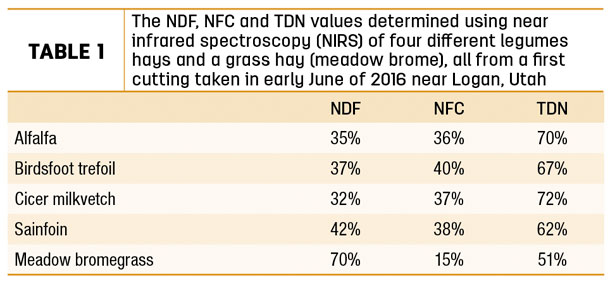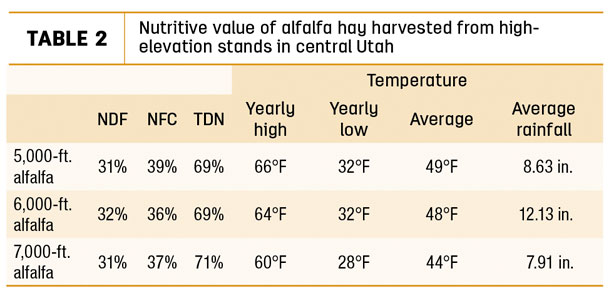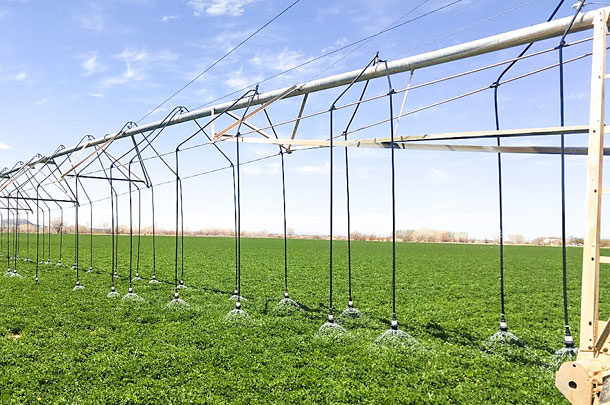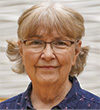Data from Utah State University on the nutritive value of perennial legumes may upend conventional wisdom when it comes to Mountain West hay.
The high quality of Mountain West alfalfa hay is usually attributed to cooler growing-season temperatures at high elevations. Alfalfa cultivars with greater fall dormancy are often better adapted to the shorter growing seasons at higher elevations, and slower growth initiation could improve alfalfa quality. Cooler temperatures seem to reduce alfalfa stem elongation, resulting in a higher leaf-to-stem ratio for alfalfa grown at higher elevations.
Shorter stems need less structural tissue and therefore would have less fiber and lignin. While these growth differences in high-elevation alfalfa have been noticed, until now there’s been no research dedicated to understanding the effect of the cooler, drier climates of the Mountain West on alfalfa quality.
Non-fibrous carbohydrates are the source of energy in beef finishing and dairy cow diets, and include starch and water-soluble carbohydrates like sugars and fructans, as well as readily digestible fiber. The total digestible nutrient (TDN) concentration of ruminant diets includes non-fibrous carbohydrates, and increasing dietary TDN can increase ruminant production. Non-fibrous carbohydrates are especially valuable in beef finishing diets because the marbling that makes meat tender and juicy requires high-energy feed.
The non-fibrous carbohydrate (NFC) concentration of feeds is calculated by the difference after measuring fiber, protein, fat and ash concentrations, and a value of 25% is reasonable for alfalfa hay. The NFC concentration of grains like corn is around 75%, and the NFC concentration of corn silage and diet components such as beet pulp is typically 35% to 40%. Studies at Utah State University show the NFC concentration of Mountain West-grown alfalfa and other perennial legumes is also in the range of 40%.
The value of the elevated non-fibrous carbohydrates found in Mountain West alfalfa and other legumes was demonstrated in a beef finishing study carried out at Utah State University. Dr. Jennifer MacAdam, a plant physiologist studying the management of pastures for beef and dairy production, finished yearling steers in a feedlot or on pastures that contained either monoculture birdsfoot trefoil or monoculture meadow bromegrass.
Birdsfoot trefoil is a deep-rooted perennial legume that’s finer-stemmed and lower-yielding than alfalfa but similar in forage quality. Consumers found the meat from the legume-finished steers to be as tender and juicy as the feedlot-finished beef, and they liked the feedlot and the legume pasture-finished beef better than the grass-finished beef.
When the non-fibrous carbohydrate concentrations of the feedlot and the legume pasture diets were compared, their concentrations were both about 40%, which was twice that of the grass pasture diet. When the NFC concentration of hay made from alfalfa and other perennial legumes was measured, it was only about 5% less than the legume pasture, and closer to the NFC concentration of a feedlot diet than to conventional alfalfa hay (Table 1).

While the non-fibrous carbohydrates in feedlot diets come from starch, the concentrations of starch and water-soluble carbohydrates in alfalfa only account for about one-third of the non-fibrous carbohydrates, and the rest is mostly readily digestible fiber.
Marbling is dependent on a supply of glucose from the blood to intramuscular fat cells. The starch in feedlot diets results in the level of blood glucose needed for marbling. In studies where the starch in feedlot diets was replaced by citrus pulp, which is rich in readily digestible fiber, the readily digestible fiber was equal to starch in supplying blood glucose for marbling.
The goal of current alfalfa research on non-fibrous carbohydrates at Utah State University is to determine how NFCs accumulate during alfalfa growth and development. It is also important to understand the climatic factors that drive the accumulation of non-fibrous carbohydrates. The factors likely to be most important to the high quality of “mountain hay” are the cool nights and long, sunny days associated with irrigated agriculture in a semiarid climate.
Dr. Matt Yost, agroclimate extension specialist at Utah State University, is working to increase the efficiency of the irrigation systems used by Utah hay producers and has collected alfalfa samples from a range of different elevations. The NDF, NFC and TDN values determined using near-infrared spectroscopy (NIRS) in Table 2 are for alfalfa hay samples taken from producers’ fields located at approximately 5,000, 6,000 and 7,000 feet in elevation in the central part of Utah.

The table also contains temperature and rainfall data for these locations. These data are preliminary, but there was no apparent difference in NFC values over the growing season or with change in elevation. The values for NFC and TDN are consistent with the perennial legume hays in Table 1 that are from a site at approximately 4,500 feet in elevation.
Documenting the energy value and the components of non-fibrous carbohydrates in Mountain West alfalfa hay will benefit Western hay producers by providing the data needed to market hay with elevated NFC concentration for dairy and beef production. We hope to survey alfalfa hay from a wide range of irrigated, semiarid western U.S. locations in the future to determine the climate parameters that result in alfalfa with elevated NFC concentration. ![]()
PHOTO: The factors likely to be most important to the high quality of “mountain hay” are the cool nights and long, sunny days associated with irrigated agriculture in a semiarid climate. Photo provided by Jennifer MacAdam.
Matt Yost is an agroclimate extension specialist at Utah State University.

-
Jennifer MacAdam
- Professor
- Department of Plants, Soils and Climate
- Utah State University
- Email Jennifer MacAdam












